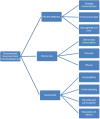The Training to Improve Dyspnoea Study- Patient Experiences of Using a High Frequency Airway Oscillating Device
- PMID: 38887676
- PMCID: PMC11182029
- DOI: 10.2147/COPD.S443186
The Training to Improve Dyspnoea Study- Patient Experiences of Using a High Frequency Airway Oscillating Device
Abstract
Introduction: The High Frequency Airway Oscillating device (HFAO) was developed to help patients with COPD feel less breathless through flow resistive respiratory muscle training and fixed rate oscillations. Previous work has demonstrated that this device can improve inspiratory muscle strength over and above a sham device. Both groups improved their breathlessness and preserved clinical benefits though there were no statistically significant differences seen over and above the sham device. It is important to understand patient perceptions of using a device and how this may influence their treatment and therefore a qualitative analysis was conducted to understand participant experiences of a HFAO device.
Methods: This was an exploratory qualitative analysis involving participants recruited to the Training to Improve Dyspnoea (TIDe) study. Participants completed a satisfaction survey and were invited to take part in a focus group. Focus groups were conducted by a researcher independent to the randomised controlled trial. Data was analysed independently by two researchers using inductive thematic analysis, and themes/sub-themes were agreed jointly. Data is presented in themes and sub themes and triangulated with survey response data.
Results: Fourteen participants were recruited to two focus groups (71% male, mean [SD] age 64[9] years). The key themes were patient selection, device use, and investment. Patient selection explores the disease characteristics, emotional impact and management of care. Device use explores the device prescription and usage, routine and lifestyle and effectiveness. Investment covers accessibility, understanding, benefits vs participation and overall perceptions of the device.
Conclusion: This research demonstrates the complexity of device interventions and that key considerations should be given to patient selection, the device use itself and, the time and cost investment required for participants to successfully implement the device into daily life.
Keywords: COPD; breathlessness; qualitative.
© 2024 Daynes et al.
Conflict of interest statement
Enya Daynes was awarded an educational grant from Actegy LTD for this study. The authors report no other conflicts of interest in this work.
Figures
References
-
- Global Strategy For The Diagnosis, Management And Prevention Of Chronic Obstructive Pulmonary Disease. Global Initiative for Chronic Obstructive Lung Disease; 2006.
-
- Weiner P, Magadle R, Beckerman M, Weiner M, Berar-Yanay N. Comparison of specific expiratory, inspiratory, and combined muscle training programs in COPD. Chest. 2003;124(4):1357–1364. - PubMed
MeSH terms
LinkOut - more resources
Full Text Sources
Medical



